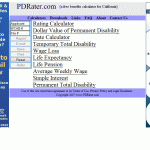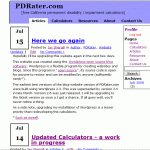Calculator Issues
Calculator Performance Issue: It has come to my attention that some users are having problems with the “Body Part” code finder. This problem apparently occurs when you click on the “Body Part” button and just see a spinning blue “waiting” disc instead of a list of body parts.
Temporary Fix: Even though the Body Part code search function does not work for some users, the rating functions still appears to work just fine. If you know the Body Part code, you should be able to enter it manually in the box provided. If you are performing a 2005 schedule rating, please use the full 8 digit body part code.
Permanent Solution: I am working on a fix for this problem and will update this website as soon as I am able. I cannot be sure, but I suspect that the problem is being caused, in part, by the recent increase in the popularity of this website. ((Yay, popularity! Boo, problems!))
To all paid-subscription users:
I value your business and appreciate your patience. If this problem persists, I will create a second website exclusively for your use.
In the meantime, if you’re having problems with the calculators, however small, please e-mail through the Contact Us link at the top. The more information I have about the problem, the better able I will be to diagnose and fix it.
Thank you again for your patience.
Sincerely,
Jay Shergill






